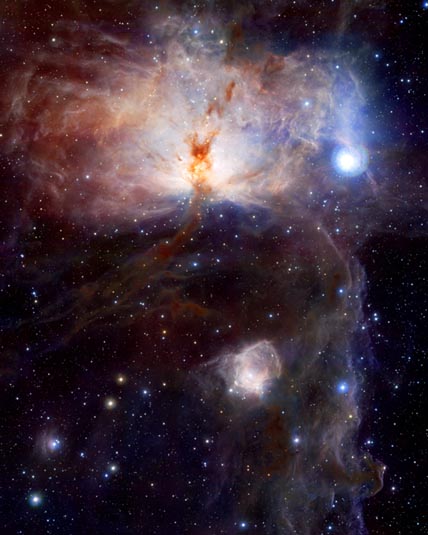
(infrared)
Emission nebula
RA 5h 41m 42.73s Dec -1° 54' 44.18"
Orion
900-1,500 light years
2
30 x 30 arcmin
42.92 x 52.52 arcminutes
14 minutes
North is 10.0° left of vertical
ESO/J. Emerson/VISTA.& Cambridge Astronomical Survey Unit
December 11, 2009
Infrared view Visible widefield view Horsehead nebula
ABOUT THIS IMAGE:
A
new telescope - VISTA (the Visible and Infrared Survey Telescope for Astronomy)
is the latest telescope to be added to ESO's Paranal Observatory in the
Atacama Desert of northern Chile. It is housed on the peak adjacent to
the one hosting the ESO Very Large Telescope (VLT) and shares the same
exceptional observing conditions. VISTA's main mirror is 4.1 meters across
and is the most highly curved mirror of this size and quality ever made
- its deviations from a perfect surface are less than a few thousandths
of the thickness of a human hair - and its construction and polishing
presented formidable challenges.
At the heart of VISTA is a 3-ton camera containing 16 special detectors
sensitive to infrared light, with a combined total of 67 million pixels.
Observing at wavelengths longer than those visible with the human eye
allows VISTA to study objects that are otherwise impossible to see in
visible light because they are either too cool, obscured by dust clouds
or because they are so far away that their light has been stretched beyond
the visible range by the expansion of the Universe. To avoid swamping
the faint infrared radiation coming from space, the camera has to be cooled
to -200 degrees Celsius and is sealed with the largest infrared-transparent
window ever made. The VISTA camera was designed and built by a consortium
including the Rutherford Appleton Laboratory, the UK ATC and the University
of Durham in the United Kingdom.
This image, the first to be released publicly from VISTA, the world's
largest survey telescope, shows the spectacular star-forming region known
as the Flame Nebula, or NGC 2024, in the constellation of Orion (the Hunter)
and its surroundings. In views of this evocative object in visible light,
the core of the nebula is completely hidden behind obscuring dust, but
in this VISTA view, taken in infrared light, the cluster of very young
stars at the object's heart is revealed. The wide-field VISTA view also
includes the glow of the reflection nebula NGC 2023, just below center,
and the ghostly outline of the Horsehead Nebula (Barnard 33) towards the
lower right. The bright bluish star towards the right is one of the three
bright stars forming the Belt of Orion. The image was created from VISTA
images taken through J, H and Ks filters in the near-infrared part of
the spectrum. The image shows about half the area of the full VISTA field
and is about 40 x 50 arcminutes in extent.